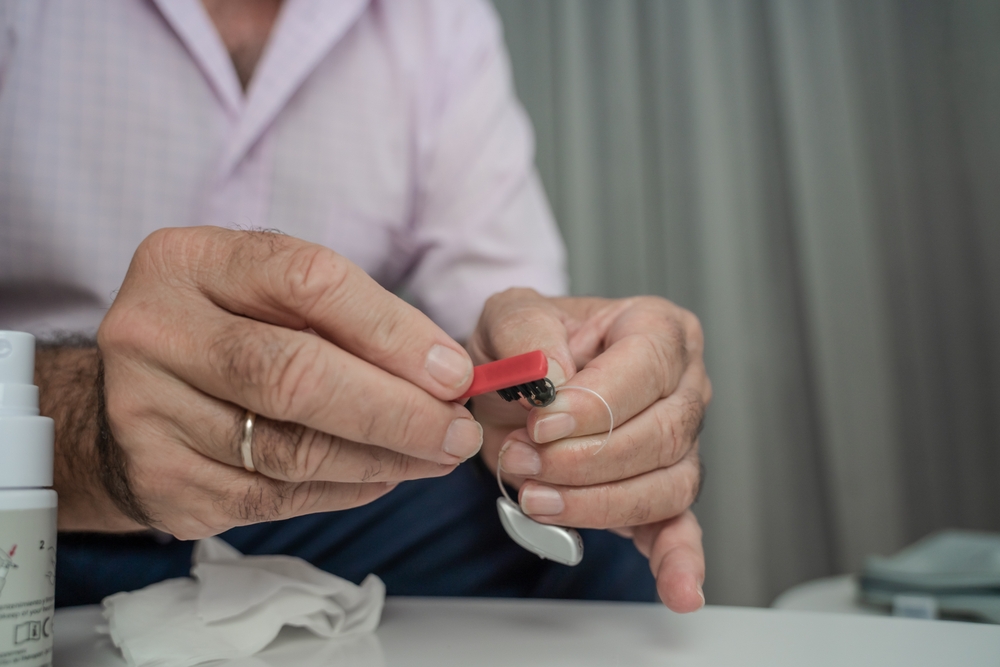
After you have become accustomed to using your hearing aid, it becomes a critical element of your everyday routine. The idea of it breaking down can be challenging, not only because of the inconvenience but also thanks to the prospective cost of repairs or replacements.
Tips for maintaining and optimizing your hearing aid functionality
By recognizing the prospective hazards that can damage your hearing aid and taking steps to maintain it correctly, you can protect its performance and continue to appreciate the improved quality of life it offers.
Proper battery maintenance
The effectiveness of your hearing aid depends significantly on its battery. Hence, it is important to choose the correct batteries for your device. Talk to your hearing specialist to figure out the ideal battery type for your model.
Handling the batteries with care is equally important. The natural oils, dirt, and moisture on your skin can transfer to the batteries and cause contamination, compromising their functionality and potentially leading to damage.
Before replacing the battery, ensure your hands are clean and completely dry to keep any moisture from entering the device.
Adhere closely to the manufacturer’s instructions, especially regarding battery maintenance. To extend the battery life of your hearing aid, be certain to power it off when not using it and keep it stored in a secure, dry location. Knowing the typical lifespan of a battery can also be really handy.
Note on your calendar when you change the battery, so you can prepare for when it needs to be switched out. It’s essential to have a spare battery with you at all times, specifically when you are not at home, in order to prevent being left without power all of a sudden.
Prevent moisture damage
Hearing aids, being technological devices, are vulnerable to moisture. Even slight contact can cause harm or complete failure of the device. To safeguard your hearing aid, consider purchasing a dehumidifier developed specifically for hearing aids. This device supplies a secure and dry atmosphere for your hearing aid when not in use, safeguarding it from damage caused by excessive moisture.
To safeguard your hearing aid from water damage, it’s a smart plan to take it out before participating in activities that make you sweat heavily. Consult taking off your hearing aid to exercise, especially outdoors, with your hearing specialist, as doing so could jeopardize your safety by reducing your recognition of essential auditory cues, such as traffic noises or warning alarms. If necessary, go with indoor exercise where it’s safer to be without your hearing aid, and always remember to remove your device before showering or going for a swim.
Also, avoid utilizing hairspray, spray deodorants, and other aerosol products while using your hearing aid. These products contain moisture and chemicals that can accumulate on the device, resulting in long-term damage. In order to minimize exposure, use these types of products before putting in your hearing aids.
Prevent excessive ear wax accumulation
Though earwax plays a protective role by keeping dust, insects, and other foreign debris out of your ears, it can pose a challenge for your hearing aid. The accumulation of earwax in the device can lead to it not working properly. To manage this, have your ears checked out by your hearing specialist or physician to evaluate the level of earwax buildup and create an appropriate cleaning routine for both your ears and your hearing aid.
Cleaning your ears safely is crucial– never insert foreign objects into your ear canal. Instead, allow warm water to flow into your ears in the course of showers, which can help break up and wash away some of the wax. Routine professional ear cleaning is also advisable. Though this may be a bit of a hassle, it’s a trivial issue in comparison to the frustration and complications that can arise from a hearing aid that’s not functioning properly due to a buildup of earwax.
To properly clean your hearing aid, carefully adhere to the guidelines provided by the manufacturer.
Different types of hearing aids may require different cleaning techniques, and using the wrong method could cause harm to your device. If you’re unsure about the proper cleaning method, consult your hearing specialist or hearing aid provider to ensure you’re taking the correct steps to protect your device from earwax damage.
Easy techniques to ensure lasting dependability
Once you get used to wearing your hearing aids, they become a crucial facet of your daily routine, making it difficult to envision life without them. By applying a few simple safety measures, you can safeguard your hearing aids from harm and maintain their reliability over the long run. Routine maintenance, proper storage, and careful handling are essential to keeping your hearing aids in optimal condition, allowing you to continue enjoying the improved quality of life they supply.
If you are having problems with your hearing aid or need to book a routine maintenance appointment, please arrange for a visit.

